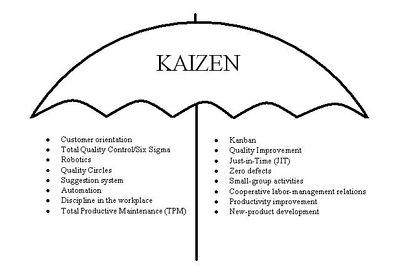Kaizen
| Kaizen |
|---|
| See also |
Kaizen a Japanese term which describes approach to continuous improvement by improving in small steps, long-term, one by one. The Kaizen is based on improving, not investment. The investment in new technology doesn't solve the problems. It only replaces old, well-known problems with new, yet unknown. Sometimes investment is necessary, but it shouldn't be a first solution to choose. The Kaizen means:
KAI = CHANGE ZEN = GOOD The Kaizen is change for the better |
In Kaizen the quality the aim of daily life, not only during working hours. The improvement should be gradual and infinite. It should pursue the perfection. The employees should be continuously engaged in company's life and improvement of every aspect of the company (processes, products, infrastructure, etc.). This improvement throughout all aspects of life is related to the great attention that is paid to needs and requirements of customer.
Kaizen focuses on teams (quality circles), promotes teamwork and team spirit, however it also recognizes the individual contribution. It emphasizes the engagement of each worker to the concept and vision of the company, so that employees will identify themselves with the enterprise, its culture and objectives.
The important aspects of Kaizen are:
- What is wrong? not who is wrong?
- How to eliminate waste (Muda)
- How to decrease quality costs
The waste is being eliminated by empowering people with tools and provision of methodology for uncovering improvement opportunities and making small changes. This is a low cost approach, that uses simple quality control tools: Pareto, Ishikawa diagrams and PDCA cycle.
History of Kaizen method
The idea of Kaizen is stored deeply in the consciousness of Japanese. It stems from the roots of eastern philosophy. In that philosophy the most important is the way leading to excellence. The excellence itself can be out of reach, as an ideal. The success of Kaizen in Japan and other countries of the region is related to the philosophy. The problems with this idea and its methods (quality circles, commitment) in western countries become obvious when compared to the western (especially Greek) philosophy.
The history of contemporary Kaizen in production companies begins after World War II when Toyota first implemented quality circles in its production process. Quality circles were formed of workers at the production site. Taiichi Ohno, a former Executive Vice-President of Toyota Motor Company implemented Toyota Production System which aimed at system of continuous improvement in quality, technology, processes, company culture, productivity, safety and leadership. This revolutionary concept became very popular in Japan in the 50s and contributed to later success on global market.
In 1986 Masaaki Imai introduced to the Western world the Japanese term Kaizen and made it famous through his book, Kaizen: The Key to Japan's Competitive Success.
10 Principles of Kaizen process
Full description of principles is presented in spearate article: Kaizen principles.
- Say no to status quo
- If something is wrong, correct it
- Accept no excuses and make things happen
- Improve everything continuously
- Abolish old, traditional concepts
- Be economical
- Empower everyone to take part in problems' solving
- Before making decisions, ask "why" five times to get to the root cause
- Get information and opinions from multiple people
- Remember that improvement has no limits. Never stop trying to improve
Kaizen umbrella
The Kaizen umbrella (fig. 1.) is a set of methods and approaches that describe this philosophy:
- Customer orientation - fulfilling the customers needs is our main objective
- Total Quality Control - statistical process control and other statistical tools are necessary to understand the process. Six sigma is based on TQC, it's just more American approach.
- Robotics and automation - automation can help, but it's not the ultimate solution in every problem
- Quality circles - engage your employees
- Suggestion system - everyone can suggest a change, even if he/she doesn't work in the process
- Discipline in the workplace means 5S method everywhere
- Total Productive Maintenance (TPM) allows to maximize performance of production
- Kanban methodology smooths the production processes
- Just in time (JIT) smooths cooperation with business partners
- Quality improvement is the key to success
- Zero defects is a concept of ultimate improvement, idea of Philip B. Crosby
- Small-group activities help enhance teamwork
- Cooperative relations between managers and employees improve information flow
- Productivity improvement is the effect of the program
- New product development is required to keep us in the business
References
- Marksberry, P., Badurdeen, F., Gregory, B., & Kreafle, K. (2010). Management directed kaizen: Toyota's Jishuken process for management development. "Journal of Manufacturing Technology Management", No. 21(6), pp. 670-686
- Masaaki Imai, Kaizen (Ky' zen) The Key to Japan's Competitive Success, McGraw Hill, Inc., New York 1986
- Masaaki Imai, Gemba - Kaizen, A Commonsense, Low-Cost Approach to Management, McGraw Hill Companies, Inc., New York 1997
- Paul Brunet, A., & New, S. (2003). Kaizen in Japan: an empirical study. International Journal of Operations & Production Management, No. 23(12), pp. 1426-1446
- Singh, J., & Singh, H. (2009). Kaizen philosophy: a review of literature. "The Icfai University Journal of Operations Management", No. 8(2), pp. 51-72
- Definition - Kaizen Institute
Author: Magdalena Mleczkowska, Slawomir Wawak
